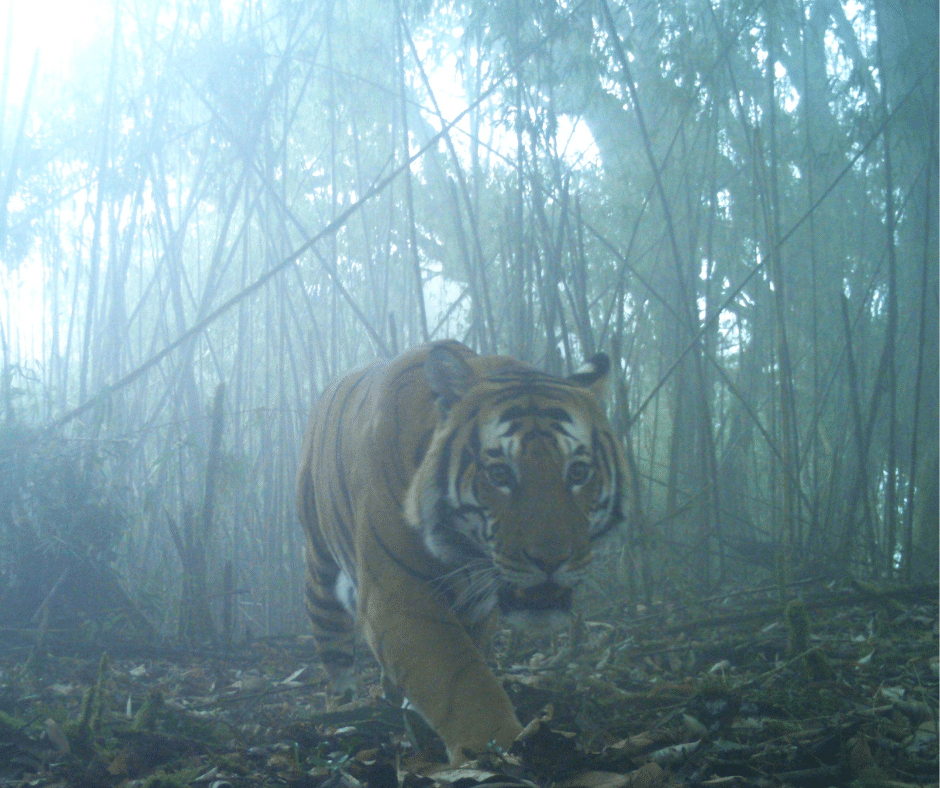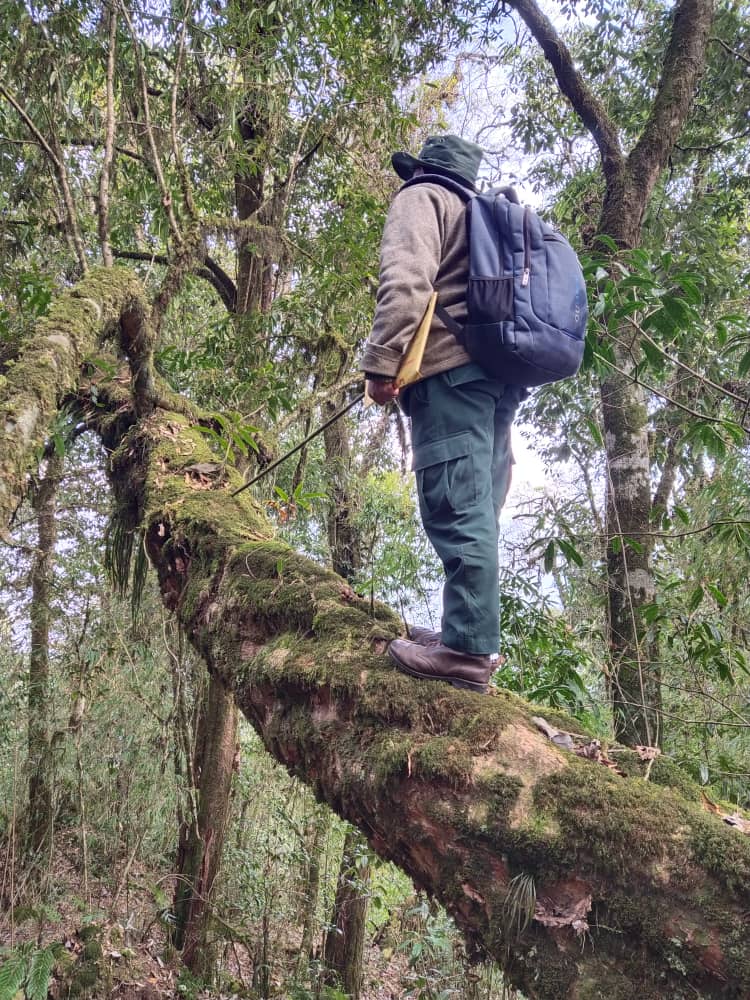
We're expanding our community-based red panda conservation programs to Bhutan and we have some encouraging updates to share!
In September 2019, Bhutan published its five-year red panda conservation plan. Red Panda Network (RPN) played a key role in advocating for and developing the plan, and also helping ensure its effective implementation under the leadership of Bhutan’s Ministry of Agriculture and Forests, Nepal’s Department of National Parks and Wildlife Conservation, and the Department of Forest and Soil Conservation. We’re excited to share the progress we’ve made thus far.
Bhutan’s red panda conservation plan had three primary objectives:
- Objective 1: Improve red panda monitoring capabilities
- Objective 2: Develop an understanding of red panda habitat usage and the conservation threats they face in the southwest region of Bhutan
- Objective 3: Enhance awareness of red panda conservation within local communities
 Camera trap photograph of tiger in Bhutan. Credit: Nature Conservation Division/DoFPS
Camera trap photograph of tiger in Bhutan. Credit: Nature Conservation Division/DoFPS
Objective 1. Improve red panda monitoring capabilities
In order to accurately collect data to help develop red panda conservation strategies, we needed to ensure there were clear procedures and training to help familiarize the survey team and educate new team members.
RPN worked with a team of forestry officials with expertise in red panda conservation to develop the Red Panda Monitoring Protocol for Bhutan. The protocol covered training on survey design and methods, including both theory and practical sessions that gave participants hands-on experience in collecting data. A team of eight officials across four field divisions were trained as part of the “training of trainers” (ToT) program using the protocol. These officials then trained the survey team members within their divisions.
 Red panda survey in Bhutan. Credit: Nature Conservation Division/DoFPS
Red panda survey in Bhutan. Credit: Nature Conservation Division/DoFPS
Objective 2. Develop an understanding of red panda habitat usage and the conservation threats they face in the southwest region of Bhutan
The team identified potential red panda habitats using forest type, altitude, and proximity to human settlements as parameters. They overlaid a 4x4 square kilometer biodiversity monitoring grid over the territory and identified 135 grids to survey. Half of these grids were surveyed for signs of red pandas and for vegetation sampling, the other half were selected for camera trapping.
Red Panda Sign Survey
Within each grid, the survey team walked trail paths (also called transects) of four-to-eight kilometers, searching for signs of red pandas. When the trails were shorter than 4 kilometers, the team surveyed three shorter trails of at least 1 kilometer in distance. For each trail, the survey team laid out a 25-meter radius plot at the start, and then additional 25M radius plots every 500 meters along the length of the trail. Within those plots, the survey team searched for direct sightings of red pandas, and evidence of any red panda activity.
During these surveys, the team also evaluated the vegetation structure and composition of the red panda habitats. Tree heights and diameters were measured and recorded to determine the basal area (or the average amount of an area occupied by tree stems, canopy cover, and forest density). Bamboo and shrubs were counted, and measured for height, while herb species were also recorded. In addition, the team collected other physical parameters such as aspect, elevation, slope, and distance to water source.
The survey teams recorded many direct sightings of red pandas, and also found evidence of red panda activity through droppings and tracks.

Red panda habitat survey in Bhutan. Credit: Nature Conservation Division/DoFPS

Red panda droppings. Credit: Nature Conservation Division/DoFPS
Camera trapping
Camera traps were installed in 50% of the survey grids in order to find evidence of red pandas and complement the data gathered through the sign survey. The camera traps were monitored at least once during the study period in order to replace batteries and memory cards, and ensure camera functionality. After three months, the survey team retrieved the data from the camera traps.

Installing camera traps in Bhutan. Credit: Nature Conservation Division/DoFPS
Sign Survey and Camera Trap Findings
In total, the team surveyed a total of 1083 plots (25 m radius) and confirmed the presence of red pandas in the Gedu Forest Division, Dagana Forest Division, Samtse Forest Division, and Jigme Khesar Strict Nature Reserve. The team estimates that only 10% of the southwest Bhutan region is habitable for red pandas.
 Wild red panda in Bhutan (photographed on camera trap). Credit: Nature Conservation Division/DoFPS
Wild red panda in Bhutan (photographed on camera trap). Credit: Nature Conservation Division/DoFPS
 Marbled cat photographed on camera trap in Bhutan. Credit: Nature Conservation Division/DoFPS
Marbled cat photographed on camera trap in Bhutan. Credit: Nature Conservation Division/DoFPS
Potential Red Panda Threats
Over 50% of the surveyed plots had evidence of threats to red pandas. The most common threats were signs of livestock farming (observed in 37% of plots), non-timber forest product (NTFP) collection (17%), timber harvesting (13%), infrastructure (6%), and stray dogs (2%). One positive finding was the survey team did not record any signs of red pandas being hunted.
Objective 3: Enhance awareness of red panda conservation within local communities
The team conducted a survey of 350 people across the four districts to understand perceptions on red panda conservation from communities residing in and around red panda habitats. A semi-structured questionnaire was used to collect information from local households, and qualitative insights were captured during focus group discussions. During the focus groups, the survey team informed participants about the need and importance of red panda conservation.
Nearly 50% of the respondents did not have any knowledge about red pandas. Those who were familiar with red pandas knew of them either from direct sightings or learned about the animal from secondary sources. However, over 90% of the respondents were very familiar with nature conservation laws. And 2 of 3 respondents responded positively to the importance of red panda conservation.
Based on these findings, the Bhutan teams are developing plans to conduct awareness campaigns and developing educational resources and materials to be used in schools.
 Community survey in Bhutan. Credit: Nature Conservation Division/DoFPS
Community survey in Bhutan. Credit: Nature Conservation Division/DoFPS
We are encouraged by our progress and share enthusiasm with our Bhutan partners. "The support and collaboration with Red panda Network has helped us expand red panda conservation in Bhutan and the research provided new insights on red panda habitat suitability and connectivity between different conservation landscapes. The work has also helped us take a bigger step toward red panda conservation by exploring the genetics of red panda in Bhutan," says Letro who is the Sr. Forestry Officer with the Nature Conservation Division of Bhutan's Department of Forests & Park Services.
RPN's Country Director in Nepal, Ang Phuri Sherpa, shares his optimism regarding our work in Bhutan: "As a part of red panda range countries initiatives, this a first step we have taken in Bhutan to help understand red panda's habitat preference, distribution and its conservation threats in south-western Bhutan bordering India. I am sure that the results of the study will be a stepping stone for formulating a transboundary red panda conservation action plan."
Download our report to review the study findings in more detail! Learn more about our work in Bhutan.
 Red Panda pawprints in Bhutan. Credit: Nature Conservation Division/DoFPS
Red Panda pawprints in Bhutan. Credit: Nature Conservation Division/DoFPS
Brian Sim
Writing and Communications Volunteer
Red Panda Network
